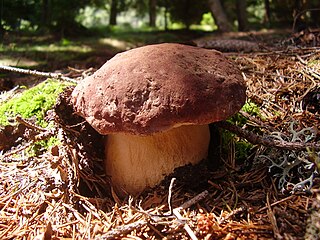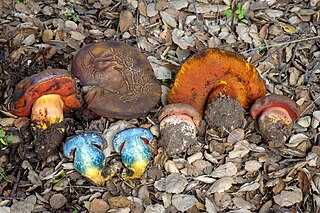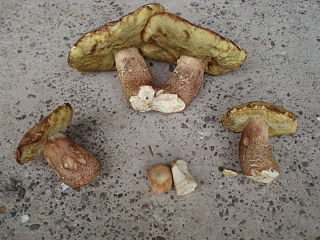
The Boletales are an order of Agaricomycetes containing over 1300 species with a diverse array of fruiting body types. The boletes are the best known members of this group, and until recently, the Boletales were thought to only contain boletes. The Boletales are now known to contain distinct groups of agarics, puffballs, and other fruiting-body types.

Boletus edulis is a basidiomycete fungus, and the type species of the genus Boletus. Widely distributed in the Northern Hemisphere across Europe, Asia, and North America, it does not occur naturally in the Southern Hemisphere, although it has been introduced to southern Africa, Australia, New Zealand, and Brazil. Several closely related European mushrooms formerly thought to be varieties or forms of B. edulis have been shown using molecular phylogenetic analysis to be distinct species, and others previously classed as separate species are conspecific with this species. The western North American species commonly known as the California king bolete is a large, darker-coloured variant first formally identified in 2007.

The Boletaceae are a family of mushroom-forming fungi, primarily characterised by small pores on the spore-bearing hymenial surface, instead of gills as are found in most agarics. Nearly as widely distributed as the agarics, the family is renowned for hosting some prime edible species highly sought after by mushroom hunters worldwide, such as the cep or king bolete . A number of rare or threatened species are also present in the family, that have become the focus of increasing conservation concerns. As a whole, the typical members of the family are commonly known as boletes.

Suillus luteus is a bolete fungus, and the type species of the genus Suillus. A common fungus native all across Eurasia from Ireland to Korea, it has been introduced widely elsewhere, including North and South America, southern Africa, Australia and New Zealand. Commonly referred to as slippery jack or sticky bun in English-speaking countries, its names refer to the brown cap, which is characteristically slimy in wet conditions. The fungus, initially described as Boletus luteus by Carl Linnaeus in 1753, is now classified in a different fungus family as well as genus. Suillus luteus is edible, though not as highly regarded as other bolete mushrooms. It is commonly prepared and eaten in soups, stews or fried dishes. The slime coating, however, may cause indigestion if not removed before eating. It is often sold as a dried mushroom.

Boletus is a genus of mushroom-producing fungi, comprising over 100 species. The genus Boletus was originally broadly defined and described by Carl Linnaeus in 1753, essentially containing all fungi with hymenial pores instead of gills. Since then, other genera have been defined gradually, such as Tylopilus by Petter Adolf Karsten in 1881, and old names such as Leccinum have been resurrected or redefined. Some mushrooms listed in older books as members of the genus have now been placed in separate genera. These include such as Boletus scaber, now Leccinum scabrum, Tylopilus felleus, Chalciporus piperatus and Suillus luteus. Most boletes have been found to be ectomycorrhizal fungi, which means that they form a mutualistic relationship with the roots system of certain kinds of plants. More recently, Boletus has been found to be massively polyphyletic, with only a small percentage of the over 300 species that have been assigned to Boletus actually belonging there and necessitating the description and resurrection of many more genera.

Caloboletus calopus, commonly known as the bitter beech bolete or scarlet-stemmed bolete, is a fungus of the bolete family, found in Asia, Northern Europe and North America. Appearing in coniferous and deciduous woodland in summer and autumn, the stout fruit bodies are attractively coloured, with a beige to olive cap up to 15 cm (6 in) across, yellow pores, and a reddish stipe up to 15 cm (6 in) long and 5 cm (2 in) wide. The pale yellow flesh stains blue when broken or bruised.

Boletus aereus, the dark cep or bronze bolete, is a highly prized and much sought-after edible mushroom in the family Boletaceae. The bolete is widely consumed in Spain, France, Italy, Greece, and generally throughout the Mediterranean. Described in 1789 by French mycologist Pierre Bulliard, it is closely related to several other European boletes, including B. reticulatus, B. pinophilus, and the popular B. edulis. Some populations in North Africa have in the past been classified as a separate species, B. mamorensis, but have been shown to be phylogenetically conspecific to B. aereus and this taxon is now regarded as a synonym.

Boletus reticulatus, and commonly referred to as the summer cep is a basidiomycete fungus of the genus Boletus. It occurs in deciduous forests of Europe, where it forms a symbiotic mycorrhizal relationship with species of oak (Quercus). The fungus produces fruiting bodies in the summer months which are edible and popularly collected. The summer cep was formally described by Jacob Christian Schäffer as Boletus reticulatus in 1774, which took precedence over B. aestivalis as described by Jean-Jacques Paulet in 1793.

Boletus barrowsii, also known in English as the white king bolete after its pale colored cap, is an edible and highly regarded fungus in the genus Boletus that inhabits western North America. Found under ponderosa pine and live oak in autumn, it was considered a color variant of the similarly edible B. edulis for many years.

Boletus pinophilus, commonly known as the pine bolete or pinewood king bolete, is a basidiomycete fungus of the genus Boletus found throughout Europe and western Asia. Described by Italian naturalist Carlo Vittadini in 1835, B. pinophilus was for many years considered a subspecies or form of the porcini mushroom B. edulis before genetic studies confirmed its distinct status. In 2008, B. pinophilus in western North America were reclassified as a new species, B. rex-veris. B. pinophilus is edible, and may be preserved and cooked.

Exsudoporus frostii, commonly known as Frost's bolete or the apple bolete, is a bolete fungus first described scientifically in 1874. A member of the family Boletaceae, the mushrooms produced by the fungus have tubes and pores instead of gills on the underside of their caps. Exsudoporus frostii is distributed in the eastern United States from Maine to Georgia, and in the southwest from Arizona extending south to Mexico and Costa Rica. A mycorrhizal species, its fruit bodies are typically found growing near hardwood trees, especially oak.

Butyriboletus appendiculatus is an edible pored mushroom that grows under oaks and other broad leaved trees such as beech. It is commonly known as the butter bolete. It often grows in large colonies beneath the oak trees, and is frequently found cohabiting with old oaks in ancient woodland. It is relatively rare in Britain. Its stipe and pores are often bright yellow and its flesh stains bright blue when cut or bruised.

Suillellus amygdalinus is a fungus of the bolete family found in western North America. The fruit bodies, or mushrooms, are characterized by their thick, red to brown caps, red pores, and the strong bluing reaction observed when the mushroom tissue is injured or cut. The cap can reach diameters of up to 12 cm (4.7 in) and the stipe 9 cm (3.5 in) long by 3 cm (1.2 in) thick at maturity. This mushroom has been found in manzanita and madrone woodlands of central California north to southern Oregon. Although the edibility of the mushroom is not known with certainty, it may be poisonous, and is not recommended for consumption. Other similar red-pored, bluing boletes from North America, including Rubroboletus eastwoodiae, Boletus luridiformis, and B. subvelutipes, can be distinguished from S. amygdalinus either by the color of the cap, the degree of reticulation on the stipe, or by location.

Boletus regineus, commonly known as the queen bolete, is an edible and highly regarded fungus of the genus Boletus that inhabits southwestern North America. It was considered a variant of the similarly edible B. edulis for many years until declared a unique species in 2008. Phylogenetic analysis has shown B. regineus as a member of a clade, or closely related group, with B. subcaerulescens, Gastroboletus subalpinus, B. pinophilus, B. fibrillosus, and B. rex-veris.

Boletus fibrillosus is a basidiomycete fungus of the genus Boletus found in western North America. The fruiting bodies are found in mixed coastal forests in the fall, usually singly or in small groups. The cap is up to 17 cm wide, buff to brown to dark brown in color, and has a wrinkled to finely fibrous texture. The tubes are yellow, while the flesh is white to buff and does not stain when cut. The stem is yellowish at the top, brown otherwise, with a reticulate texture, and mycelium enshrouding the bottom. The holotype was collected in Mendocino County, California. The species is edible, but considered to have inferior taste to other edible boletes such as B. edulis, which it is often confused with.

Boletus subcaerulescens is a basidiomycete fungus of the genus Boletus found in northeastern North America. The fruiting bodies are found associated with pine and spruce. The cap is up to 18 cm wide, convex to flat, and brown in color. The tubes are yellow and stain blue when bruised, while the flesh is white to buff and does not stain when cut. The stem is brown like the cap and has a light-colored reticulate texture.

Boletus rubriceps is a species of bolete fungus in the family Boletaceae. Although it was officially described as new to science in 2014, the bolete had previously been reported as either Boletus edulis or B. pinophilus. Molecular analysis showed that it was sufficiently different from other morphologically similar Boletus species to warrant designation as a distinct species. It is found in the southwestern United States and southern Rocky Mountains, where it associates with spruce, pine, and sometimes fir. The fruit bodies are edible and highly sought after; they are often sold in farmer's markets of Arizona, New Mexico, and Colorado, and are used in some restaurants. The specific epithet refers to the reddish color of the caps. Common names given to the bolete include "Ruby Porcini", "Rocky Mountain red-capped king bolete” or “Rocky Mountain red".
Boletus albobrunnescens is a species of bolete fungus in the family Boletaceae. It is classified in the section Boletus of the genus Boletus, commonly known as the porcini mushrooms. First reported to science in 2010, the species was officially described in 2014. It is found in mixed evergreen and deciduous forests of Thailand, where it fruits singly to scattered in soil under Pinus and Castanopsis trees. Its fruit bodies have caps measuring 5.5–11 cm (2.2–4.3 in) in diameter. They are white but stain brown to reddish brown, hence the epithet, which combines the Latin words for "white" (albo) and "becoming brown" (brunnescens). The stipe measures 6–11 cm (2.4–4.3 in) long by 1.5–2 cm (0.6–0.8 in) thick except for the swollen base, which is up to 5 cm (2 in) in diameter. The top of the stipe has a prominent network pattern (reticulations) that diminishes as it extends down to over half its length. Like the cap, it also stains brown after handling. The smooth spores are roughly spindle-shaped (fusoid), and measure 10.5–11.9 by 4.2–4.9 μm.

Imleria badia, commonly known as the bay bolete, is an edible, pored mushroom found in Eurasia and North America, where it grows in coniferous or mixed woods on the ground or on decaying tree stumps, sometimes in prolific numbers. Both the common and scientific names refer to the bay- or chestnut-coloured cap, which is almost spherical in young specimens before broadening and flattening out to a diameter up to 15 cm (6 in). On the cap underside are small yellowish pores that turn dull blue-grey when bruised. The smooth, cylindrical stipe, measuring 4–9 cm long by 1–2 cm thick, is coloured like the cap, but paler. Some varieties have been described from eastern North America, differing from the main type in both macroscopic and microscopic morphology.



















